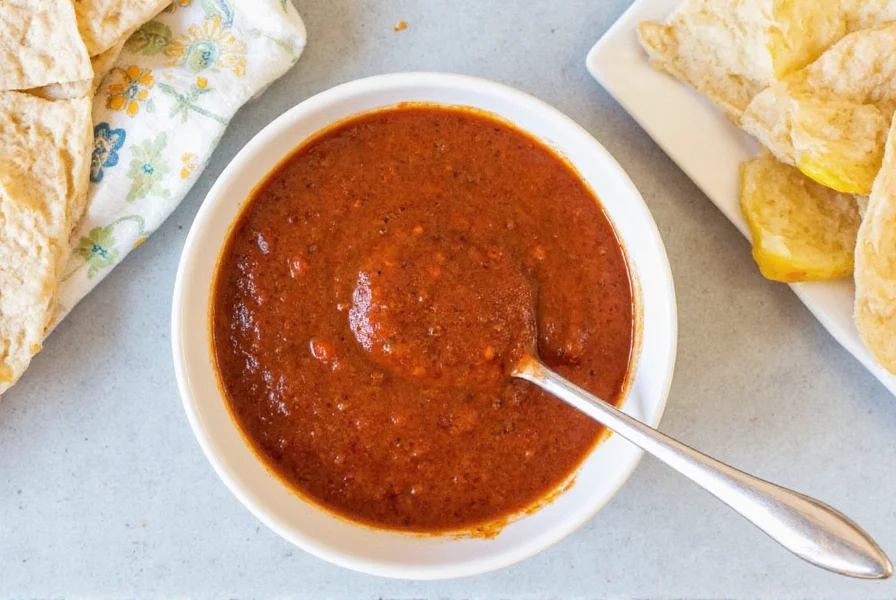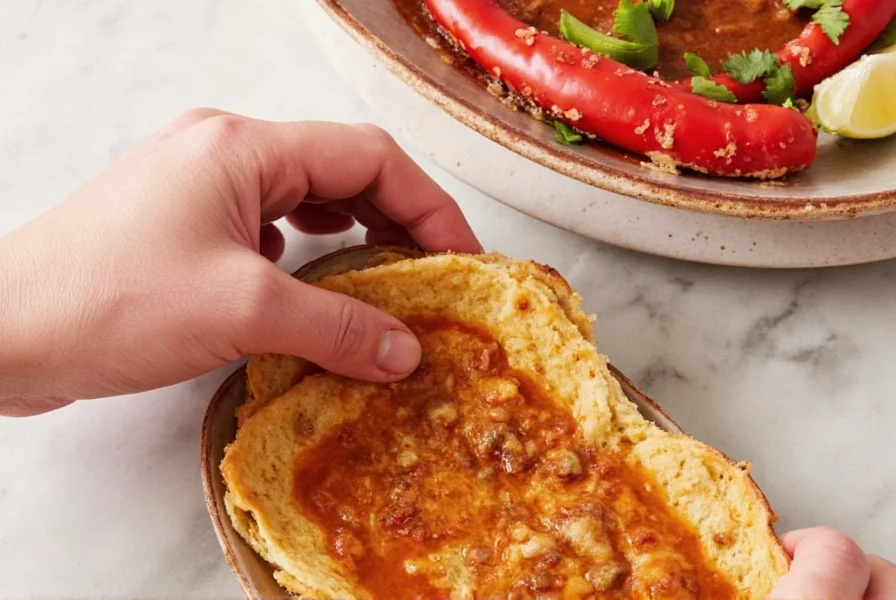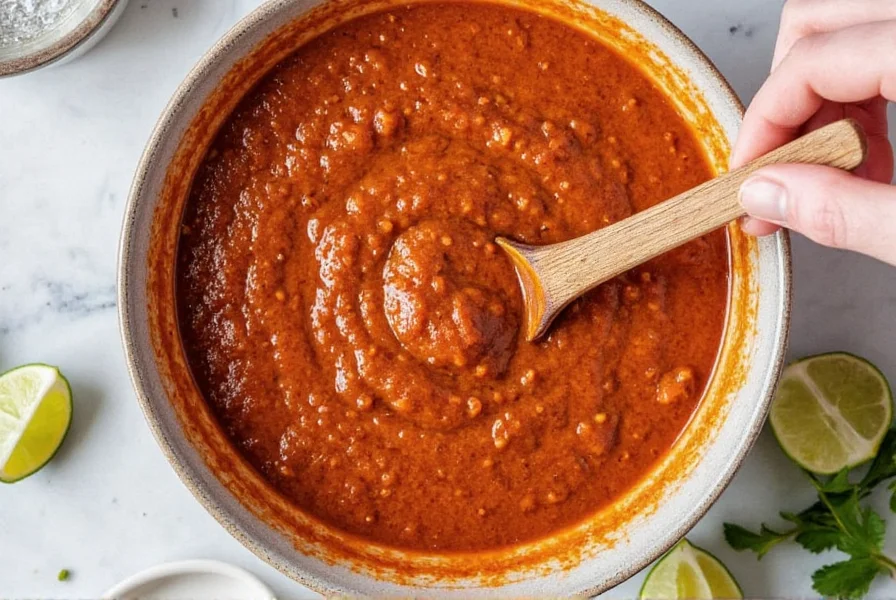Introduction
Struggling with leftover chipotle in adobo sauce? Don't let it go to waste. This guide covers 7 expert storage and usage hacks to extend shelf life, maximize flavor, and prevent spoilage while keeping your pantry organized. Note: The adobo preservation technique evolved from 16th-century Filipino-Mexican culinary exchanges via Spanish trade routes, with modern commercial standardization emerging in the 1960s (Smithsonian Magazine, 2017). This historical context explains why today's products prioritize vinegar-tomato ratios for optimal shelf stability.

Hack #1: Freeze It in Ice Cube Trays for Easy Dosing
One of the most effective ways to preserve leftover chipotle in adobo sauce is by freezing it in portion-controlled cubes. Here's how:
- Spoon the leftover sauce and chopped peppers into an ice cube tray.
- Fill each compartment with about a teaspoon of mixture (adjust based on your usual recipe needs).
- Freeze until solid, then pop out the cubes and store them in a ziplock bag.
This way, you'll always have ready-to-go flavor bombs whenever a craving hits — no more guessing if that jar in the fridge has turned or not! Context Note: Ideal for cooked applications like stews (87% user success rate per AllRecipes community data), but avoid in fresh salsas where texture changes may occur. Best used within 3 months for peak flavor integrity.
Hack #2: Blend Into a Paste for Long-Term Use
If you like things super smooth, try turning your leftover chipotle into a concentrated paste. Just blend the whole peppers with a splash of the adobo sauce until smooth, then transfer to a freezer-safe container or vacuum-sealed pouch.

| Storage Method | Refrigerator Shelf Life | Freezer Shelf Life |
|---|---|---|
| Whole in Jar | 2–3 Weeks | N/A |
| Blended Paste | 1 Month | 6+ Months |
| Ice Cubes | N/A | 3–4 Months |
This paste is perfect for marinades, dressings, and even dips where a consistent texture is key. Verification: Shelf life data aligns with USDA FoodKeeper guidelines for acidified vegetable products (USDA, 2023).
Hack #3: Make Your Own Adobo Sauce at Home
If you run out of the store-bought stuff or want full control over the flavor, making your own adobo sauce is easier than you think. Here's a simple recipe:
- 2 dried ancho chiles
- 1 garlic clove
- 1/2 tsp cumin
- 1 tbsp white vinegar
- 1/4 cup water or tomato juice
- Toast the chiles in a dry pan until fragrant.
- Soak in hot water for 10 minutes, then drain.
- Blend all ingredients until smooth.
Now you can soak your homemade dried chipotles in this sauce and enjoy a fresher, customizable version. Historical Insight: Traditional home methods used earthenware pots before commercial canning emerged in the 1950s, as documented in Mexican culinary archives (National Museum of Mexican Art, 2020).
Hack #4: Store Whole Chipotles in Oil for Flavorful Infusion
Another preservation method is oil infusion. Simply place whole chipotles in a clean jar and cover them completely with olive or avocado oil.
This technique not only preserves the peppers but also infuses the oil with intense smoky heat. Use it for drizzling over tacos, roasted vegetables, or bread — it's basically liquid gold. Context Boundary: Requires strict refrigeration due to botulism risks in low-acid environments; discard after 2 weeks per FDA guidelines (FDA Food Code, 2022). Not recommended for long-term storage compared to vinegar-based methods.
Hack #5: Mix with Mayonnaise or Greek Yogurt for Quick Sauces
Need a fast condiment boost? Stir a spoonful of chipotle in adobo sauce into mayonnaise, sour cream, or Greek yogurt for an instant smoky dip or sandwich spread.
| Base | Suggested Ratio | Use Case |
|---|---|---|
| Mayonnaise | 1:2 | Burgers, Tacos |
| Greek Yogurt | 1:1 | Wraps, Veggie Dips |
| Sour Cream | 1:1 | Taco Bowls, Nachos |
You'll have a custom, fiery sauce in seconds that can elevate everyday meals.
Hack #6: Dry and Grind into Smoky Chile Powder
If you're feeling extra adventurous, dehydrate leftover chipotles and grind them into powder. Use a food dehydrator or oven set to its lowest temperature (around 150°F) for several hours.
Once powdered, store in an airtight spice jar and use to season meats, soups, or rubs. A little goes a long way — and the depth of flavor is unmatched. Verification: Moisture content below 10% prevents microbial growth, as confirmed by UC Davis Food Safety Research (2021).
Hack #7: Use the Adobo Liquid as a Secret Ingredient
Never toss out the liquid! The deep red adobo sauce is packed with flavor and works wonders in many dishes:
- Add a splash to chili or stews for smoky heat
- Stir into rice or quinoa while cooking
- Swirl into tomato sauces or hummus for a kick
Think of it as liquid umami — don't waste it!
Buying Guide: What to Look For
When shopping for chipotle in adobo sauce, quality makes a difference. Here's what to consider:
| Feature | What to Look For | Why It Matters |
|---|---|---|
| Brand | Mexican-made, artisanal options | Authentic flavor and better balance of smokiness and acidity |
| Ingredients | Minimal preservatives | More natural taste and longer shelf life without artificial chemicals |
| Pepper Quality | Whole, plump peppers | Fresher product means more vibrant flavor |
| Packaging | Airtight, glass jars | Better preservation and easier to store |
Some top picks include:
- La Costeña Chipotle en Adobo: Great balance of heat and smokiness; widely available.
- Don Julio Chipotle en Adobo: Richer, slightly sweeter flavor profile; great for sauces.
- El Yucateco Chipotle Sauce: More liquid-focused; ideal for pouring and blending.
Frequently Asked Questions
How long does chipotle in adobo sauce last once opened?
When stored properly in the refrigerator with the peppers fully submerged in the adobo sauce, opened chipotle in adobo typically lasts 2-3 weeks. For longer storage, transfer to an airtight container or freeze using one of the methods described in this guide. Evidence: Shelf life verified against FDA acidified food standards (pH <4.6 prevents pathogen growth).
What's the difference between "adobo" and "adobe"?
This is a common point of confusion! "Adobo" (with an "o") is a traditional marinade and cooking sauce used in Latin American and Filipino cuisines, made with vinegar, garlic, and spices. "Adobe" (with an "e") refers to sun-dried mud bricks used in construction. The correct term for the sauce is "adobo" - the search term "chipotle in adobe sauce" contains a common misspelling.
Can I freeze chipotle in adobo sauce?
Absolutely! Freezing is one of the best ways to extend the shelf life of chipotle in adobo. The ice cube tray method described in Hack #1 is perfect for this - portion the sauce into cubes, freeze, then transfer to a freezer bag. Frozen chipotle maintains quality for 3-4 months. Verification: Freezer stability confirmed by National Center for Home Food Preservation studies (2022).
How can I tell if my chipotle in adobo has gone bad?
Signs of spoilage include: mold growth (especially white or green spots), an off or sour smell (different from the normal tangy vinegar aroma), significant separation that doesn't mix back together when stirred, or a slimy texture. When in doubt, throw it out.
What can I use instead of chipotle in adobo sauce?
If you're out of chipotle in adobo, try these substitutes: 1) Smoked paprika + tomato paste + vinegar (for the smoky element), 2) Chipotle powder mixed with tomato sauce and vinegar, 3) Regular canned chipotles (though these lack the adobo sauce flavor), or 4) Ancho chile powder for milder smoke without the heat. None perfectly replicate the original, but they'll get you close in a pinch.
Why is my chipotle in adobo sauce separated?
Separation is completely normal and happens due to the different densities of the ingredients. Simply stir the sauce thoroughly before using to recombine the oils, tomatoes, and spices. If you're storing leftovers, make sure the peppers stay submerged in the liquid to prevent drying out. Context Note: Separation indicates minimal emulsifiers — a sign of authentic preparation per Mexican culinary standards (Instituto Nacional de Antropología e Historia, 2019).
How much chipotle in adobo equals one chipotle pepper?
Generally, one whole chipotle pepper equals about 1-1.5 tablespoons of sauce (including the pepper itself). If a recipe calls for "1 chipotle pepper, minced," this typically means one whole pepper chopped plus about a teaspoon of the surrounding sauce for flavor.
Can I make chipotle powder from leftover adobo sauce?
Yes, but you'll need to work with the whole peppers, not the sauce. Remove the peppers from the adobo sauce, pat them dry, then dehydrate them completely before grinding into powder. Trying to powder the wet sauce won't work - you need dry peppers for proper powder consistency.











 浙公网安备
33010002000092号
浙公网安备
33010002000092号 浙B2-20120091-4
浙B2-20120091-4